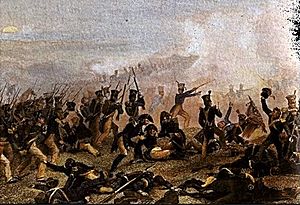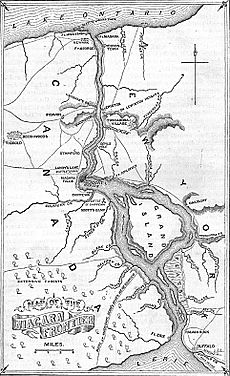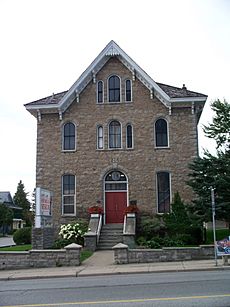Battle of Lundy's Lane facts for kids
Quick facts for kids Battle of Lundy's Lane |
|||||||
|---|---|---|---|---|---|---|---|
| Part of the War of 1812 | |||||||
 Battle of Lundy's Lane, Alonzo Chappel |
|||||||
|
|||||||
| Belligerents | |||||||
| Commanders and leaders | |||||||
| Strength | |||||||
| 3,500 | 2,500 | ||||||
| Casualties and losses | |||||||
| 84 killed 559 wounded 169 captured 55 missing |
174 killed |
||||||
| Official name: Battle of Lundy's Lane National Historic Site of Canada | |||||||
| Designated: | 1937 | ||||||
The Battle of Lundy's Lane, also called the Battle of Niagara Falls, happened on July 25, 1814. It was a major fight during the War of 1812. American soldiers fought against British and Canadian forces near what is now Niagara Falls, Ontario. This battle was one of the bloodiest of the war. More than 1,700 soldiers were hurt or killed.
Neither side truly won the battle that day. Both armies suffered many losses. However, the American army had to pull back because they lost so many soldiers. This meant the British gained an advantage in the war.
Contents
Why Did the Battle of Lundy's Lane Happen?
On July 3, 1814, an American army led by Major General Jacob Brown crossed the Niagara River. They quickly captured Fort Erie, a British fort. Then, they moved north. A few days later, American soldiers under Brigadier General Winfield Scott defeated a British force at the Battle of Chippawa.
After this victory, Brown's army tried to get around the British defenses. The British then moved back to Fort George. Brown's army did not have enough soldiers or large cannons to attack Fort George. Also, British ships controlled Lake Ontario, so Brown could not get more supplies or troops by water.
For most of July, Brown's army stayed in Queenston. They were often attacked by Canadian militia and First Nation warriors. On July 24, Brown decided to move his army back to the Chippawa River. He wanted to get more supplies. As soon as Brown left, British soldiers moved forward to Lundy's Lane. This spot was about 4 miles (6.4 km) north of the Chippawa River.
The Battle Begins
How the Armies Moved into Position
On July 25, 1814, Lieutenant General Gordon Drummond arrived at Fort George. He was the British leader for Upper Canada. Drummond immediately ordered some of his troops to march south. He hoped this would make the American army leave the area.
Instead, General Brown ordered his American troops to march north. He wanted to force the British to call back their soldiers to protect Fort George. The Americans did not know that the British had a strong force waiting at Lundy's Lane.

When the British leader, Major General Phineas Riall, learned the Americans were coming, he first ordered his troops to fall back. But General Drummond quickly arrived with more soldiers. He ordered the British to hold their ground at Lundy's Lane. The first American soldiers arrived around 6:00 p.m.
Scott's First Attack
Lundy's Lane was on a small hill, about 25 feet higher than the land around it. This gave a good view of the area. The British placed their cannons in a cemetery at the highest point.
The American 1st Brigade, led by Winfield Scott, came out of a forest into an open field. The British cannons caused heavy damage to Scott's soldiers. Scott sent the 25th U.S. Infantry to go around the left side of the British line. These American soldiers found an old path. They used it to get behind the British. They surprised the British and Canadian soldiers there and pushed them back.
The American soldiers also captured many wounded British soldiers and messengers. One of these prisoners was Major General Riall, who had been hurt. This action by the Americans forced the British to move their center back. This left their cannons unprotected.
Brown's Main Attack
By nightfall, Scott's soldiers had suffered many losses. General Brown arrived with the main American army. This included the 2nd Brigade and a group of volunteer soldiers. As these new troops took over from Scott's tired soldiers, Brown gave an important order. He told Lieutenant Colonel James Miller to capture the British cannons. Miller famously replied, "I'll try, Sir."
While some American soldiers attacked the British right side, Miller's troops moved very close to the British cannons. They fired their muskets, killing most of the British gunners. Then, they charged with bayonets. They captured the cannons and pushed the British off the hill. The British tried to fight back but were stopped by Miller's and Ripley's soldiers.
Meanwhile, another British group arrived. They were tired and confused. They accidentally ran into the American soldiers and were also pushed back. They lost their own cannons.
Drummond's Counter-Attacks
General Drummond, who was wounded in the neck, quickly gathered his troops. He ordered a strong attack to get his cannons back. The British attacked in a straight line. The Americans fought back with musket fire over the captured cannons. Both sides lost many soldiers.
Drummond did not give up. He launched a second attack, using the same method. Some American soldiers hesitated, but they were rallied and held their ground. During this fighting, Winfield Scott led his remaining soldiers in another attack. Scott's men fought both the British and some American units who didn't recognize them. Drummond's line was pushed back, but Scott's soldiers also became disorganized. Scott was badly wounded soon after.
Just before midnight, Drummond launched a third attack. He used every soldier he could find. The fighting over the cannons was very close, with soldiers even using bayonets. But again, the tired British soldiers had to fall back.
The End of the Battle
By midnight, both armies were exhausted. Only about 700 American soldiers were still able to fight. Winfield Scott and Jacob Brown were both seriously wounded. Brown would get better, but Scott's injury meant he could not continue fighting in the campaign.
With low supplies and water, Brown ordered a retreat. The American army began to pull back. The British still had about 1,400 soldiers on the field. However, they were too tired to stop the Americans from leaving.
The American cannon crews had suffered greatly. It was hard to find enough horses to pull all the cannons away. One American cannon was lost during the close fighting. Another cannon had to be left behind because its carriage was broken. The Americans did manage to take one captured British cannon with them.
What Happened After the Battle?

Early on July 26, General Brown ordered his soldiers to go back and get the abandoned British cannons. But when they returned, they found that Drummond's British army had already taken back the battlefield. The British now had 2,200 soldiers there. The Americans decided to withdraw without fighting again.
The American army then moved back to Fort Erie. They destroyed the old British forts along the Chippawa River and burned the bridges. They also had to leave behind or destroy much of their equipment. This was to make room for the wounded soldiers on their wagons.
The British saw this as a victory. The Americans had lost so many soldiers that they were now outnumbered. They were forced to retreat to Fort Erie. This meant the British had gained the upper hand in the Niagara area.
Soldiers Lost in the Battle
The British officially reported 84 soldiers killed, 559 wounded, 42 captured, and 193 missing. Later, it was confirmed that the Americans captured 19 British officers and 150 other soldiers. This changed the British losses to 84 killed, 559 wounded, 169 captured, and 55 missing.
The American official report first listed 171 killed, 572 wounded, and 117 missing. Later, this was updated to 174 killed, 572 wounded, 79 captured, and 28 missing. Some soldiers first listed as missing were later confirmed to have been killed.
Battlefield and Memorials

The battle site was named a National Historic Site of Canada in 1937.
Today, the area where the battle happened is a busy part of Niagara Falls, Ontario. A small part of the battlefield is kept as a memorial. It is next to the Drummond Hill Cemetery on Lundy's Lane. Other memorials there include:
- Soldier's Monument – built by the Canadian Parliament in 1895.
- Commemorative Wall – added in 2004.
- Laura Secord Monument – Laura Secord is buried at Drummond Hill Cemetery.
Legacy of the Battle
- Lieutenant Colonel James Miller's famous reply, "I'll try, Sir," is now the motto of the 5th U.S. Infantry.
- Many active American and Canadian army units today carry battle honors from Lundy's Lane. This means they remember the history of the regiments that fought there.
- The battle is mentioned in "The Maple Leaf Forever," an unofficial Canadian patriotic song.
- In the movie Gangs of New York, a character mentions his father was killed by the British on July 25, 1814. This is likely a reference to the Battle of Lundy's Lane.
Orders of Battle
| British Order of Battle | American Order of Battle |
|---|---|
|
Lieutenant General Sir Gordon Drummond
|
Left Division (Major General Jacob Brown)
|
Images for kids
-
Map of the Niagara Frontier in 1814. Following Lundy's Lane, American forces fell back to Fort Erie, losing the initiative on the Niagara Peninsula.



